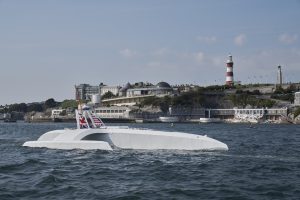A modern-day Mayflower ship with a state-of-the-art navigation system, positioning technology, and a stealth structure may not look like the vessel that set sail 400 years ago. Yet its innovative spirit will have an equivalent influence on marine exploration.
The original Mayflower set sail in 1620 with the notion that its voyage would not only change the course of history but also open a world of possibilities. This remarkable journey has now set the stage for the next phase of the Mayflower legacy, a new autonomous ship that will bear its name and make the same legendary trek from Plymouth, England to Plymouth, Massachusetts. The ship will be the world’s first full-sized, fully autonomous unmanned ship to cross the Atlantic Ocean.
From a collective of innovative minds, the groundbreaking technology powering the Mayflower Autonomous Ship (MAS) will open the door to the future of autonomous vessels and marine research. Despite delays due to COVID-19, the journey is set for the Spring of 2021 with the help of technology partners like IBM[1], Hexagon, and visionaries who have all supported the ship’s development and unique capabilities. Brett Phaneuf, President and Managing Director of Submergence Group and Marlin Submarines Ltd. (M Subs) is among the group of trailblazers that have led the way in bringing this autonomous vessel to life, with a team that specialises in design, manufacturing, and operation of manned and unmanned submersibles.
“The upside of the delay is we have a better, more reliable platform to do more sophisticated science,” said Phaneuf in a recent Velocity article, published by Hexagon’s Autonomy & Positioning division.
This additional time will also allow for further testing of things like the vessel structure to make sure it is ready to take its maiden voyage.
 In preparation for the MAS’ journey, the ship will be equipped with positioning receivers from Hexagon that will help navigate the vessel across the ocean. While the original Mayflower was impacted by severe weather during its journey, these receivers will help the autonomous ship steady its course throughout its time on the water, helping the ship reach its destination in 12 days versus the original Mayflower’s 60-day voyage. The team behind the MAS project sought out Hexagon’s positioning solutions, equipping the ship with two GNSS receivers which will provide it with the ability to use satellites to maintain reliable and precise positioning.
In preparation for the MAS’ journey, the ship will be equipped with positioning receivers from Hexagon that will help navigate the vessel across the ocean. While the original Mayflower was impacted by severe weather during its journey, these receivers will help the autonomous ship steady its course throughout its time on the water, helping the ship reach its destination in 12 days versus the original Mayflower’s 60-day voyage. The team behind the MAS project sought out Hexagon’s positioning solutions, equipping the ship with two GNSS receivers which will provide it with the ability to use satellites to maintain reliable and precise positioning.
“When you’re out at sea, if you don’t know where you are or where you’re going, then it’s not science; you might as well be writing fiction,” says Phaneuf. “It’s the fundamental thing required to do marine autonomy at all. To have accurate, reliable and precise positioning is key and you get that with [Hexagon’s] systems. This ship is going to have positioning capability above and beyond all others.”
In addition, a network of communication satellites will provide global coverage that will allow the system to identify the position of the ship in real time, an essential part of the vessel that will ensure safe navigation of the MAS.
“The outcomes from this project will not only help the advancement of autonomy in the marine industry, but the science behind it will create a greater understanding of the ocean,” said David Russell, marine segment manager for Hexagon’s Autonomy & Positioning division. “For me personally, it’s exciting to be involved in the Mayflower Autonomous Ship project and to see Hexagon’s products being used and recognized as a key part of the system.”
There is a heightened interest in the MAS, as many see it as the next great innovation in the maritime industry, offering a safer, cost-effective, and more flexible solution to the manned research vessels of today. While there are risks involved with this new venture, this fully autonomous ship will soon set sail in the name of science and adventure — inspiring the next generation of innovators.
[1] IBM Newsroom: The Mayflower Autonomous Ship
Image Credit: University of Birmingham Human Interface Technologies Team & ProMare

















